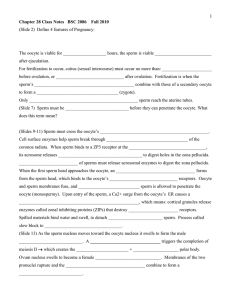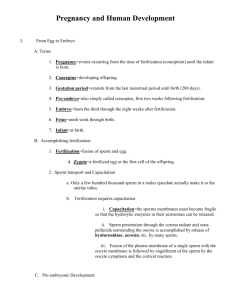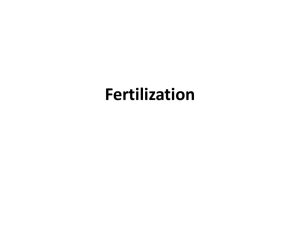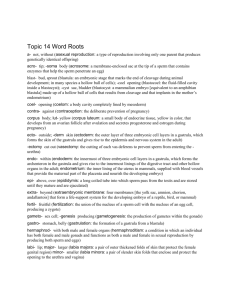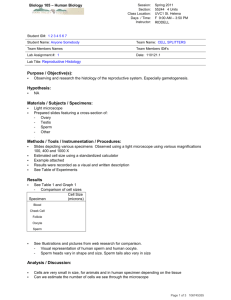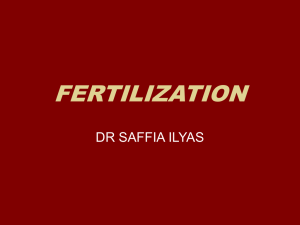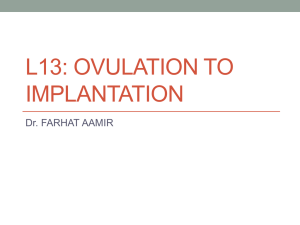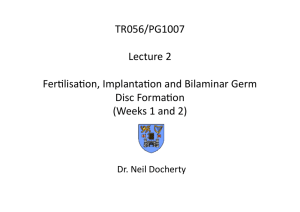Chapter 29: Development & Inheritance
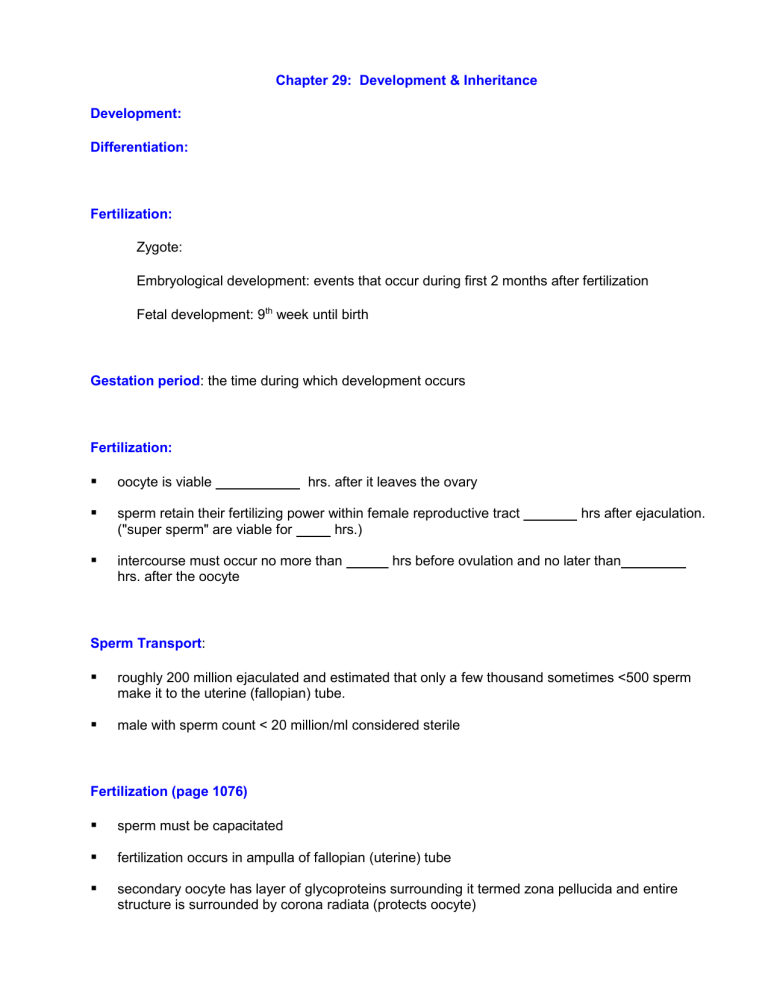
Chapter 29: Development & Inheritance
Development:
Differentiation:
Fertilization:
Zygote:
Embryological development: events that occur during first 2 months after fertilization
Fetal development: 9 th week until birth
Gestation period : the time during which development occurs
Fertilization:
oocyte is viable hrs. after it leaves the ovary
sperm retain their fertilizing power within female reproductive tract hrs after ejaculation.
("super sperm" are viable for hrs.)
intercourse must occur no more than hrs before ovulation and no later than hrs. after the oocyte
Sperm Transport :
roughly 200 million ejaculated and estimated that only a few thousand sometimes <500 sperm make it to the uterine (fallopian) tube.
male with sperm count < 20 million/ml considered sterile
Fertilization (page 1076)
sperm must be capacitated
fertilization occurs in ampulla of fallopian (uterine) tube
secondary oocyte has layer of glycoproteins surrounding it termed zona pellucida and entire structure is surrounded by corona radiata (protects oocyte)
multiple sperm necessary to create openings in corona radiata
acrosomal cap of sperm releases hyaluronidase
single sperm binds with receptors on zona pellucida of oocyte:
acrosomal cap of sperm ruptures releasing acrosin which (with hyaluronidase) digests zona pellucida so sperm can fuse with oocyte
once sperm fuses to oocyte membrane and activates it (depolarized)
depolarization also causes Ca++ ions to be released from smooth ER which:
triggers cortical reaction (exocytosis of enzymes) which inactivates sperm receptors & hardens zona pellucida
completes meiosis II
activates enzymes for mRNA for rapid protein synthesis
male pronucleus fuses with female pronucleus = zygote
Pre-embryonic Development (page 1079 figure 29-2)
Cleavage : fairly rapid mitotic divisions of the zygote
not much time for growth
by 36 hrs. after fertilization, the 1st cleavage division produces
2 ID cells which divide to produce 4 cells then 8: eventually form solid ball of cells termed morula
cleavage begins with the zygote and ends with the blastocyst
Blastocyst :
blastocoele: inner cavity
trophoblast
inner cell mass
Implantation (pg. 1080 figure 29-3)
-when the blastocyst reaches the uterine cavity it usually floats
freely in uterine secretions for days: then about days after ovulation the process of implantation begins.
Trophoblast thickens
cellular trophoblast (cytotrophoblast): cells closest to the interior
syncytial trophoblast (syncytiotrophoblast) secretes hyaluronidase into endometrium
trophoblast forms villi which grow into endometrium
implantation is completed when the blastocyst is entirely
surrounded by endometrial tissue about 14 days after ovulation.
HCG: Human Chorionic Gonadotropin: secreted by the trophoblast
this hormone prompts the corpus luteum
HCG usually detectable in mothers blood by 3rd week of gestation
HCG levels decline after 4 months
Placenta formed by third/fourth month
Placenta: originates from both embryonic & maternal (endometrial) tissues.
the trophoblast changes & becomes the chorion which develops finger like projections called choronic villi
placenta is usually fully formed and functional as a nutritive, respiratory, excretory, and endocrine organ by the month.
Gastrulation : cells move toward primitive streak (central line) (page 1081 figure 29-4)
Produces 3 layered sheet of cells termed embryonic disc which will become the embryo
placenta secretes HCG, produces estrogen, progesterone
ectoderm: superficial cells
mesoderm
endoderm
Embryonic Membranes formed from rest of blastocyst
Embryonic Development:
Embryonic membranes: amnion, yolk sac, chorion, & allantois
1. amnion
produces a bouyant environment that protects the developing embryo against physical trauma & helps to maintain
fluid also keeps the rapidly growing embryonic parts from adhering & fusing together & allows the embryo
initially amniotic fluid derived from mother's blood, but
the water portion turns over rapidly
2. yolk sac: small sac hangs from the ventral surface of the embryo in birds & reptiles
human eggs contain very little yolk
3. chorion:
arises from the trophoblast to help
4. allantois:
in egg-laying animals:
in humans
Fetal Circulation
Umbilical cord contains umbilical arteries & vein
umbilical arteries: transport blood from _________ to _________ .
umbilical vein: transports blood from to __ .
Shunts:
ductus venosus
ductus arteriosus
foramen ovale
Effects of Pregnancy on the Mother
uterus:
abdominal organs:
relaxin
weight gain:
urinary:
cardiovascular system
